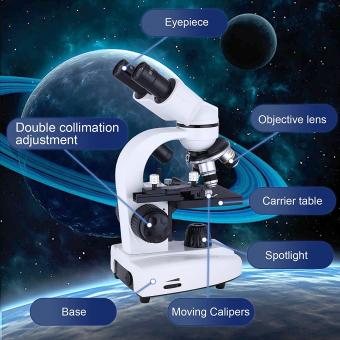How Does Dna Look Like Under Microscope ?
Under a microscope, DNA appears as a long, thin, and thread-like structure. It is not visible to the naked eye and requires high magnification to be observed. DNA molecules are typically coiled and tightly packed, forming a structure known as a double helix. The double helix resembles a twisted ladder, with two strands that are connected by a series of paired nucleotides. These nucleotides consist of four different bases: adenine (A), thymine (T), cytosine (C), and guanine (G). The specific sequence of these bases along the DNA molecule carries the genetic information. When viewed under a microscope, DNA may appear as a series of dark bands or lines, depending on the staining technique used to visualize it.
1、 DNA structure: Double helix composed of nucleotide base pairs.
DNA, or deoxyribonucleic acid, is a molecule that contains the genetic instructions for the development and functioning of all living organisms. When observed under a microscope, the structure of DNA appears as a double helix composed of nucleotide base pairs.
The double helix structure of DNA was first proposed by James Watson and Francis Crick in 1953, based on the work of Rosalind Franklin and Maurice Wilkins. This structure consists of two strands that wind around each other in a spiral shape, resembling a twisted ladder. The strands are made up of nucleotides, which are the building blocks of DNA.
Each nucleotide consists of three components: a sugar molecule called deoxyribose, a phosphate group, and a nitrogenous base. The nitrogenous bases include adenine (A), thymine (T), cytosine (C), and guanine (G). These bases pair up with each other in a specific manner: A always pairs with T, and C always pairs with G. This pairing is known as complementary base pairing.
Under a microscope, the double helix structure of DNA can be visualized using techniques such as X-ray crystallography or electron microscopy. X-ray crystallography provides a detailed three-dimensional image of the DNA molecule, revealing the precise arrangement of the nucleotides and the overall shape of the helix. Electron microscopy, on the other hand, allows for the visualization of DNA at a higher magnification, providing a more detailed view of the individual nucleotides and base pairs.
It is important to note that the latest advancements in microscopy techniques have allowed scientists to study DNA at an even higher resolution. For example, cryo-electron microscopy (cryo-EM) has revolutionized the field by enabling the visualization of biomolecules, including DNA, at near-atomic resolution. This technique involves freezing the sample to preserve its structure and then imaging it using an electron microscope. Cryo-EM has provided unprecedented insights into the fine details of DNA structure and dynamics.
In conclusion, when observed under a microscope, DNA appears as a double helix composed of nucleotide base pairs. The structure of DNA has been extensively studied and confirmed through various microscopy techniques, with recent advancements allowing for even higher resolution imaging. These advancements continue to deepen our understanding of DNA and its role in genetics and biology.

2、 Chromosomes: DNA tightly coiled around proteins in the nucleus.
Under a microscope, DNA appears as a complex structure known as chromosomes. Chromosomes are formed when DNA molecules tightly coil around proteins called histones in the nucleus of a cell. This coiling allows for the efficient packaging of DNA, which is essential for its proper functioning.
The structure of DNA was first discovered by James Watson and Francis Crick in 1953, and since then, advancements in microscopy techniques have allowed scientists to observe chromosomes in greater detail. When stained with specific dyes, chromosomes can be visualized as distinct, thread-like structures within the nucleus.
Each chromosome consists of two identical sister chromatids, which are held together at a region called the centromere. The chromatids contain the DNA molecule, which is a long, double-stranded helix. The DNA helix is made up of nucleotides, which are the building blocks of DNA. These nucleotides consist of a sugar molecule, a phosphate group, and one of four nitrogenous bases: adenine (A), thymine (T), cytosine (C), and guanine (G).
The latest advancements in microscopy, such as super-resolution microscopy, have allowed scientists to observe chromosomes at an even higher resolution. This has revealed that chromosomes are not simply linear structures but have a more complex three-dimensional organization. Chromosomes are organized into distinct territories within the nucleus, and specific regions of DNA are spatially arranged to facilitate gene expression and regulation.
In conclusion, under a microscope, DNA appears as tightly coiled chromosomes within the nucleus of a cell. The latest research has provided insights into the three-dimensional organization of chromosomes, shedding light on how DNA is organized and functions within the nucleus.

3、 Nucleosomes: DNA wrapped around histone proteins forming bead-like structures.
Under a microscope, DNA appears as a complex and intricate structure. The latest understanding of DNA's appearance under a microscope involves the concept of nucleosomes. Nucleosomes are the basic units of DNA packaging in eukaryotic cells. They consist of DNA wrapped around histone proteins, forming bead-like structures.
When viewed under a microscope, nucleosomes give DNA a characteristic appearance. The DNA strand is tightly wound around a core of eight histone proteins, forming a compact structure. This coiling allows for efficient packaging of the long DNA molecule into the cell nucleus.
The bead-like structures formed by nucleosomes are connected by linker DNA, which appears as thin threads between the nucleosomes. This arrangement creates a "beads on a string" appearance when observed under a microscope.
The latest research has provided further insights into the three-dimensional organization of DNA within the nucleus. It is now understood that nucleosomes are not randomly distributed along the DNA strand. Instead, they are organized into higher-order structures called chromatin. Chromatin consists of nucleosomes that are further compacted and folded, allowing for the efficient packaging of DNA.
Advanced microscopy techniques, such as super-resolution microscopy, have enabled scientists to visualize the finer details of DNA organization. These techniques have revealed that chromatin is organized into distinct domains, with specific regions of the genome interacting with each other. This spatial organization plays a crucial role in gene regulation and other cellular processes.
In summary, under a microscope, DNA appears as nucleosomes, which are DNA wrapped around histone proteins forming bead-like structures. The latest research has provided a deeper understanding of the three-dimensional organization of DNA within the nucleus, highlighting the importance of chromatin structure in gene regulation and cellular function.

4、 Supercoiling: DNA further coiled and compacted to fit within the cell.
Under a microscope, DNA appears as a long, thin, and thread-like structure. However, the specific appearance of DNA under a microscope depends on the level of magnification and the staining techniques used. At lower magnifications, DNA may not be visible as individual strands but rather as a diffuse mass within the nucleus of a cell.
Supercoiling is a process that further compacts DNA to fit within the limited space of a cell. DNA is naturally coiled and twisted into a double helix structure, but supercoiling involves additional twisting and coiling of the DNA molecule. This process is facilitated by enzymes called topoisomerases, which introduce or remove twists in the DNA strand.
Supercoiling plays a crucial role in regulating gene expression and DNA packaging. By compacting the DNA, supercoiling allows for efficient storage and organization of genetic material within the cell. It also helps in the proper functioning of DNA replication, transcription, and repair processes.
Recent advancements in microscopy techniques, such as super-resolution microscopy, have provided new insights into the structure and dynamics of DNA. These techniques have revealed that DNA is not a static structure but rather exhibits dynamic behavior, including looping, folding, and unwinding. Supercoiling is now understood to be a dynamic process that can change in response to various cellular signals and environmental conditions.
In conclusion, under a microscope, DNA appears as a long, thin thread-like structure. Supercoiling is a process that further compacts DNA to fit within the cell. Recent advancements in microscopy techniques have enhanced our understanding of the dynamic nature of DNA and its role in cellular processes.







































